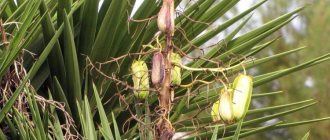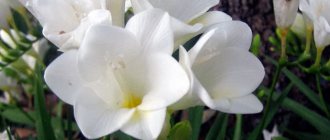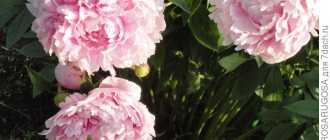Purity of petal color, beautiful shapes, rich aroma and increased vitality in different climatic zones - these are the criteria that all English roses of Austin selection meet. It was they who were guided by their creator, the British David Austin, when he wanted to remind the world about the undeservedly forgotten ancient rose bushes, and also to achieve continuous flowering.
Austin's creations have no official classification, but numerous varieties can be divided into several groups according to different characteristics. After all, when decorating personal plots, the type or height of the bushes is important for some, and the size of the flowers for others. And some gardeners just want to have some of the most beautiful roses in their garden.
Climbing varieties
Some varieties of Austin roses can be grown in the Russian climate as vines that will bloom along the entire length of the shoots. Among the best climbing representatives:
- Benjamin Britten (Benjamin Britten). Red-scarlet buds with a bright fruity aroma, which is dominated by wine, caramel and pear notes. Their size reaches 10-12 cm. Repeated flowering is observed throughout the season, in warm climates - three times. Bushes usually outgrow the 1 m mark stated in the description, and can reach 2 m or more. Flexible, prickly shoots, drooping under the weight of the inflorescences, are prone to thickening.
- Crown Princess Margareta (Crown of Princess Margareta). Tall Austin park roses with long shoots and dark green foliage. They are not afraid of low temperatures and most diseases. The variety is very healthy and hardy, even in harsh climatic conditions. The buds are particularly lush (up to 120 petals) and reach 10 cm when opened. Moreover, they do not bend to the ground even under the pressure of rain. Regular evening watering allows you to achieve the most abundant and long-lasting flowering.
Related article:
The main reasons for the death of young roses
- Gertrude Jekyll (Gertrude Jekyll). Densely leafy shrubs reaching a length of 3 m and a width of 1.85 m. 3-5 rich crimson flowers with paler edges are formed on the racemes. When opened, they reach 10 cm in diameter. The park variety is popular due to its frost resistance, ease of care, continuity and abundance of flowering. The latter can be further stimulated by removing old buds.
- Graham Thomas (Graham Thomas). One of the most popular varieties of Austin selection. It is distinguished by a very pure, rich yellow color, which usually becomes paler in the sun. Convex cup-shaped flowers, similar to peonies, have a pronounced sweet-tea aroma. They are formed on lashes 1.2-3 m long in an amount of 3-5 pieces and remain open for about 5 days. Bushes of average winter hardiness definitely need lashes tied to supports. Graham Thomas does not tolerate wet weather well and is affected by gray mold during such periods.
- The Pilgrim. Plants become climbing when grown on supports and reach three meters in length. Otherwise, they grow up to 90-120 cm and up to 90 cm in girth. Sometimes, towards the end of the season, they develop longer shoots that require pruning to maintain a beautiful bush shape. On each shoot with shiny, as if polished foliage, 1-3 buds of medium or large size are formed. They are characterized by an open rosette shape with small curling petals and a rich yellow hue with paler colors at the edge of the petals. Pilgrim is a re-blooming variety. It is well adapted to wintering in the Russian climate, but does not tolerate heavy rains.
David Austin roses: general description
Roses bred at David Austin's nursery look reminiscent of ancient ones. This is due to the fact that David used Albu, Gallic, Bourbon and Damask roses to create them. But unlike them, most windows have the following advantages:
- a wide variety of colors;
- undemanding conditions of detention;
- formation of buds along the entire length of the shoot;
- abundant and repeated (or continuous) flowering throughout the entire growing season.
English roses can live in poor soils with short daylight hours. It is enough for them to have the sun shining on them for 4 to 5 hours during the day.
David Austin paid and continues to pay special attention to the shape and color of flowers. Each of his roses must have ideal outlines. He considered the most beautiful forms of roses to be:
- cup-shaped;
- rosette;
- peony-shaped.
If the roses resulting from crossing had a different bud shape, or their color could not be called “pure,” David ruthlessly rejected them.
Another distinctive feature of ostina is its strong alluring aroma. They may smell like lemon, myrrh, tea, musk or sweet fruits. There is not a single variety in Austin's collection that lacks a bright and juicy aroma.
In recent years, David Austin has been making strict selections, regretting that he previously spent time breeding insufficiently viable roses. Therefore, modern varieties are characterized by maximum resistance to fungal infections and frost, as well as other unfavorable conditions. Despite this, most flowers suffer from rain: in wet weather, the buds stop opening, and already blooming flowers lose their attractiveness.
This is interesting! David Austin is an English farmer who has dedicated his life to breeding the perfect variety of roses. The appearance of the first “ostina” was preceded by a trip to France, where David was struck by the extraordinary beauty of ancient roses. But they bloomed only once a year. Since then, he has been fighting this absurd mistake of nature. And it turned out to be successful: today the collection of David Austin roses includes more than two hundred varieties, blooming repeatedly or continuously. And the catalog of the eminent breeder continues to be replenished with new varieties names every year.
Tall varieties
Provided good care, many ostina grown in central Russia are distinguished by greater growth compared to that indicated in the descriptions. Roses form tall bushes that do not require support. Among them are varieties such as:
- Golden Celebration. It owes its name to the rich yellow color with a copper tint, so unusual for Austin's English roses. From them, densely double cup-shaped flowers with a diameter of 8-14 cm bloom, attracting attention with a fruit and berry aroma. Round, spreading shrubs grow up to 120-150 cm, and in hot climates they can reach 200 cm as climbing crops. The stems are practically thornless, with up to 10 flower buds formed on each. Abundant flowering begins in summer and continues in waves until the end of the season.
Related article:
Park rose Morden Blush
- Lady Emma Hamilton (Lady Emma Hamilton). Neat plants growing up to 120 cm. Young shoots and leaves are characterized by a bronze color, which transforms into green as the plants develop. Inflorescences are formed from 3-5 buds. The latter, when closed, have a dark red color with orange splashes; when open, they become a bright tangerine color. The fruity-citrus aroma is especially strong between 9 and 11 am. Flowering begins in June and lasts all summer, but in rainy weather you will have to wait longer.
- Leander (Leander). Austin roses, growing up to 150-180 cm in height and up to 150 cm in girth. Against the background of shiny green leaves, the brushes formed from 5-10 pieces of small bright apricot buds stand out in contrast. Leander is considered a once-blooming plant, although single flowers may appear later.
- Spirit of Freedom. Shrubs with gray-green foliage reach a height of 120-150 cm and a girth of up to 120 cm. About 3 rosettes with dense, deep-set petals appear on the racemes formed on the shoots. They have a myrrh aroma with fruity notes. The traditional color is soft pink, sometimes lilac shades appear, size is 12-14 cm. Plants prefer sunny areas, are resistant to cold weather and practically do not get sick.
- William Morris (William Morris). Fast-growing upright shrubs reach 120-150 cm with a girth of about 90 cm. They are also suitable for growing on a support (subject to tying). On the shoots, densely double cup-shaped flowers of watercolor color are formed from a mixture of pale pink and apricot shades.
Related article:
Rose Deja Vu: description and characteristics of a hybrid tea variety
Large-flowered varieties
Large, lush flowers are characteristic of most Austin roses. Moreover, more impressive sizes can be seen only several years after planting. In addition to the Golden Celebration and Spirit of Freedom mentioned above, these varieties include:
- Abraham Darby (Abraham Darby). Rounded bushes 120-150 cm high are highly resistant to frost and disease. They produce large (up to 12-15 cm) peach buds of the classic shape of ancient roses with a bright fruity aroma. The petals are decorated with pink, golden or copper shades, which appear depending on weather conditions: the first ones prevail in cold weather, the second and third ones - in hot weather. Flowering begins one of the first and continues continuously until late autumn.
- Jubilee Celebration. Considered one of the best among Austin roses. They got their name in honor of the golden jubilee of the Queen of England. Vigorous (120-130 cm) shoots are characterized by abundant and prolonged flowering until autumn frosts. The pink petals on the reverse side have a golden hue and exude a fruity scent with notes of lemon and raspberry.
- Lady of Megginch. The densely double crimson flowers collected in inflorescences are 12-14 cm in size. As they bloom, their shape changes from cup-shaped to rosette-shaped, and the color becomes dark pink. The stems, about 120 cm high, are abundantly covered with buds and bloom almost continuously, and are highly resistant to frost and disease. Lady of Meginch is suitable not only for growing in flower beds, but also for creating borders and hedges.
Related article:
Roses from autumn cuttings
- Princess Alexandra of Kent (Princess Alexandra of Kent). A continuously flowering bush variety with graceful stems drooping to the ground under the weight of large flowers. The latter are distinguished by a densely double structure, rich pink color of the petals with a lighter tier along the outer edge. Despite their large size (10-12 cm), they tolerate rain well and stay on the shoots for at least a week, gradually changing the intense aroma from fresh tea to lemon-currant. The average dimensions of plants are 100x100 cm.
- The Dark Lady. Austin's original bright crimson roses smell brightly of rose oil. They appear on the shoots one at a time or are collected in small brushes (up to 3 pieces). They have a terry, loose structure and, when fully opened, resemble tree-like peonies. Medium-sized (about 100 cm) bushes grow well with age and prefer sunny places or partial shade.
Rose Susan Williams-Ellis
Rose Susan Williams-Ellis
Rose Susan Williams-Ellis is owned by David Austin Rosers and was bred in 2010. In areas with a warm climate, the rose begins to bloom at the end of May, in cold climates - a month later and blooms almost continuously. The flower is densely double and resembles the double flowers of mock orange. Flowers are collected in brushes of 3 pieces. one. Plant sizes start from 0.8m by 0.8m. The rose by Susan Williams-Ellis looks like Antique Roses, but the scent confirms this (rose oil) and is as strong as Antique Roses.
The main pests are aphids, caterpillars, spider mites, leafhoppers, sawflies and scale insects. Rose Susan Williams-Ellis has a slight tendency to spot, powdery mildew and rose rust. All pests and diseases will appear on it only with very poor care, otherwise it is resistant to them. In regions with high humidity and low temperatures, it must be covered. Austin rose does not tolerate shade, heavy and acidic soils, or the north side.
Ways to grow roses: heterogeneous flower beds, borders, containers, on retaining walls, trellises.
For container growing
Compact Austin varieties do well in flowerpots and containers that can be placed, for example, at the entrance to the house. But for the winter they will have to be dug under a common shelter with garden roses. Here you should pay attention to the following names:
- Anne Boleyn (Anne Boleyn). Plants are 90-110 cm high and 80-100 cm wide with freely arranged arching shoots covered with soft green glossy foliage. Double rosette flowers (up to 10 cm in diameter) have a soft pink hue with a darker back side of the petals. Collecting in large inflorescences (up to 10 pieces), they appear regularly until late autumn.
Related article:
How to insulate a rose for the winter
- Christopher Marlowe (Christopher Marlowe). Dense spreading bushes with intertwining shoots grow up to 70-90 cm and have the same diameter. The medium-sized buds will become a real decoration in the garden thanks to their bicolor color, unusual for Austin roses: the inner rows of petals are orange-pink on the inside and golden-pink on the outside. They appear throughout the summer almost continuously. They have a tea aroma with lemon notes.
- Lady of Shalott. One of the best of Austin's English roses, especially for beginning gardeners. Branched shoots about 110 cm high are resistant to diseases and frost, hardy and capable of continuous flowering even in cold, rainy summers. On each stem, 1-3 buds of bright orange color appear. As the petals open, they take on a salmon-pink hue with a golden-yellow back, which is clearly visible due to their cupped shape. The rich aroma is reminiscent of apple blossom and cloves.
- Sophy's Rose (Soufiz Rose). The main feature of the densely double raspberry-purple buds is the gradually increasing size of the petals from the center to the edges, due to which wide, fairly flat flowers are formed. Usually they are collected in the form of small brushes of 3-5 pieces. Strongly branched bushes with a small number of thorns grow up to 90 cm, bloom profusely again, and are very resistant to disease.
- Queen of Sweden/Christina (Queen of Sweden/Christina). David Austin variety with neat small (about 7 cm) flowers of a soft pink color, sometimes with an apricot tint. Deeply cupped roses gradually open to cupped rosettes and smell of myrrh. Flowering resumes throughout the summer, but after rains the decorative effect is sometimes lost. Erect, well-branched bushes with a large number of sharp thorns usually grow no higher than 120 cm.
How to properly care for plants?
English varieties do not require excessive effort to grow; they require the same measures that are carried out for any representative of the rose family. Crops do not require constant lighting. A place where sunlight falls for five hours will suit them just fine. The main thing is that in the spring it is not flooded with melt water.
Before planting, seedlings must be treated. To do this, you need to trim the roots, disinfect them with a manganese solution and soak them in water for the next 24 hours. For better results, root stimulants are added to the liquid. During the day, you need to make holes 50x50x50 cm. A distance of at least 50 cm is maintained between them, and if future roses curl, then at least 70-100 cm.
In a separate container, garden soil is mixed with peat, humus and mineral fertilizers in proportions 1:1:1. The seedlings are carefully planted in each hole, hoping that the grafting site will be 7-10 cm below the soil level. Then the roots are straightened and sprinkled with the prepared mixture. About 5 liters of water are poured under each bush. Then they compact the soil around the seedlings and hill them up so that the root system takes root better.
If the soil near the bush at a depth of 2-3 cm is dry, then the plant needs to be watered. Roses are watered in the evening, spending at least 10 liters of liquid per plant. If the variety is climbing - about 15 liters. Crops begin to be fed from the second year of life. In the spring, you can use nitrogen fertilizers when the buds appear - nitrogen-phosphorus, and in the fall you need to switch to potash, which will help the plantings survive the winter.
Pruning is carried out in autumn and spring. Old, weak or diseased shoots must be removed.
Formative pruning depends on what shape the bush needs to be obtained in the end: for a small plant with large flowers, the branches are cut by half, if the bush is wide, spreading, profusely flowering - by one third, and branched varieties are cut by only one fifth of the length. It is worth regularly removing all weeds under the bushes and loosening the soil so that the roots do not suffer from a lack of moisture and oxygen.











